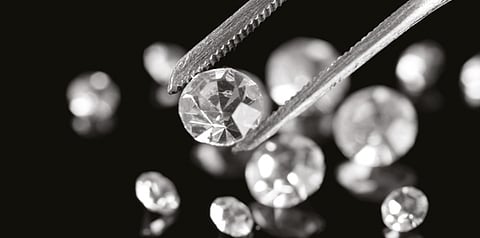

Automated Melee Screening (AMS)
De Beers supplies “Diamond Sure”, “DiamondView” and “Automated Melee Screening (AMS)” devices. The AMS manufactured by De-beers is a useful and pivotal instrument for recognizing even minute-size diamonds. The AMS machine can swiftly identify synthetic stones in parcels of small diamonds ranging from 0.01-0.20 cts in an affordable manner. The machine aims to address the market requirement for fast and cost-effective detection equipment for smaller sized diamonds.
The AMS instrument is a spectrometer based system for automatically screening potential synthetics and simulants. The instrument is controlled by a computer using proprietary software. Stones placed in a hopper are automatically fed to a fibre optic probe connected to two spectrometers which are used to record spectra. Depending on the results the stones are then dispensed into one of four result bins. Around 98 per cent of colourless/near-colourless stones will pass and require no further examination. The AMS will refer for further tests all synthetics and simulants and around 2 per cent of natural diamonds. These referred stones can then be looked at on DiamondView™.
Key Features
• Compact table top model
• Screens colourless and near-colourless round brilliant cut diamonds in the 0.01-0.20 carats size range
• Fully automated instrument will take up to 500-carats at any one time
• Throughput of each instrument is approximately 360 stones per hour
This compact screening device from De Beers is designed to determine natural diamonds from synthetics and simulants. Both loose and mounted polished stones can be tested in the 0.10 – 10 carats size range. Once the diamonds are placed on a probe and within a couple of seconds the absorption spectrum of the stone is recorded and analysed and a result is displayed. The probe design means that DiamondSure may also be used to test diamonds in a range of settings – the only requirement is that the probe is able to make direct contact with the table of each stone in the setting. The instrument is intended for colourless or near-colourless stones although it will distinguish yellow synthetics from natural cape yellow stones.
Other fancy colours will give a high referral rate and are therefore not recommended. For loose stones, the sample is placed table down on the fibre optic probe and the test button pressed. Around 98 per cent of colourless/near-colourless stones will PASS and require no further examination. All synthetics, simulants and around 2 per cent of natural diamonds (Type II and 1aB) will refer for further tests. These referred stones can then be looked at on DiamondView™. For stones mounted in jewellery the sample dish can be removed to release the fibre optic probe. This can then be used in combination with the ‘auto-detect’ function to test.
Key Features
• Compact table top model
• A portable instrument which makes a fast and effective measurement
• Designed to determine natural diamonds from synthetics and simulants
• Screens loose and mounted polished stones in the 0.10 – 10 carats size range
• Requires no user interpretation of results
D-Secure
The sole purpose of the DRC Techno’s D-secure is to uphold consumer confidence in the natural diamonds. Most of the diamonds or diamond jewellery purchases are for emotional occasions like wedding, engagement, anniversary or birthday etc. Consumer should know what they are buying. Synthetic diamond may have its own space in the jewellery segment but mixing or undisclosed synthetic diamonds with natural is something like playing with someone’s emotional value and definitely it deteriorate consumer confidence.
Most of the identification tools or instruments available in the market are either very costly or limited to some sizes, shapes, speed, accuracy or the instrument’s availability to specific clientele. Mostly instruments are only limited to identify TYPE- IIa which required further testing in Lab. It requires lots of time and energy to make sure that all purchases are full proof. After years of research of these perennial issues, we consolidate the solution in one single instrument – D-Secure.
Key Features
• Compact table top model
• Recognises synthetic diamonds in all shapes and sizes ranging from 0.003-carats to 10.00-carats
• It scans a lot of diamonds in 50 second. However, testing time varies as per size and carat weight of diamonds
• Uses multiple technologies available combined with latest Laser and Light inventions
• Enables users to test and verify diamonds already mounted on jewellery
• Precise results and require no further assessment
• Cost Approx USD 12,000
M Screen
Differentiating natural diamonds from lab-grown diamonds is becoming more and more difficult these days. Developing an automated melee screening machine was deemed necessary. To this end, WTOCD - the Antwerp research center for diamonds – has developed the M-Screen, a super-fast tabletop automatic melee screener that HRD Antwerp will commercialise. The M-Screen automatically feeds, screens and sorts out round brilliant diamonds at a super speed of minimum two diamonds per second (7.200 diamonds per hour). Depending on the size of the stones and the size of the batch, the speed can be as high as a staggering 18.000 diamonds per hour.
Key Features
• Compact table top model
• Super-fast (min. 2 diamonds/sec. Top speed of 5/sec. or 18.000 per hour)
• Processes round brilliant diamonds from 1 to 20 points, D-J colour
• Screens for Natural, Potentail lab-grown/ HPHT colour treated, Simulants
• Technology: Short wave UV light
• Reliable and consistent results
• Cost approx USD 76,417
DiamaPen
The DiamaPen® is a low-cost and highly accurate device for the screening and separation of synthetic diamonds from natural diamonds. The DiamaPen® is the perfect tool for diamond traders who need an affordable and reliable tool to detect and separate synthetic diamonds, both HPHT and CVD grown diamonds, from their natural counterparts.
Follow DiamondWorld on Instagram: @diamondworldnet
Follow DiamondWorld on Twitter: @diamondworldnet
Follow DiamondWorld on Facebook: @diamondworldnet
